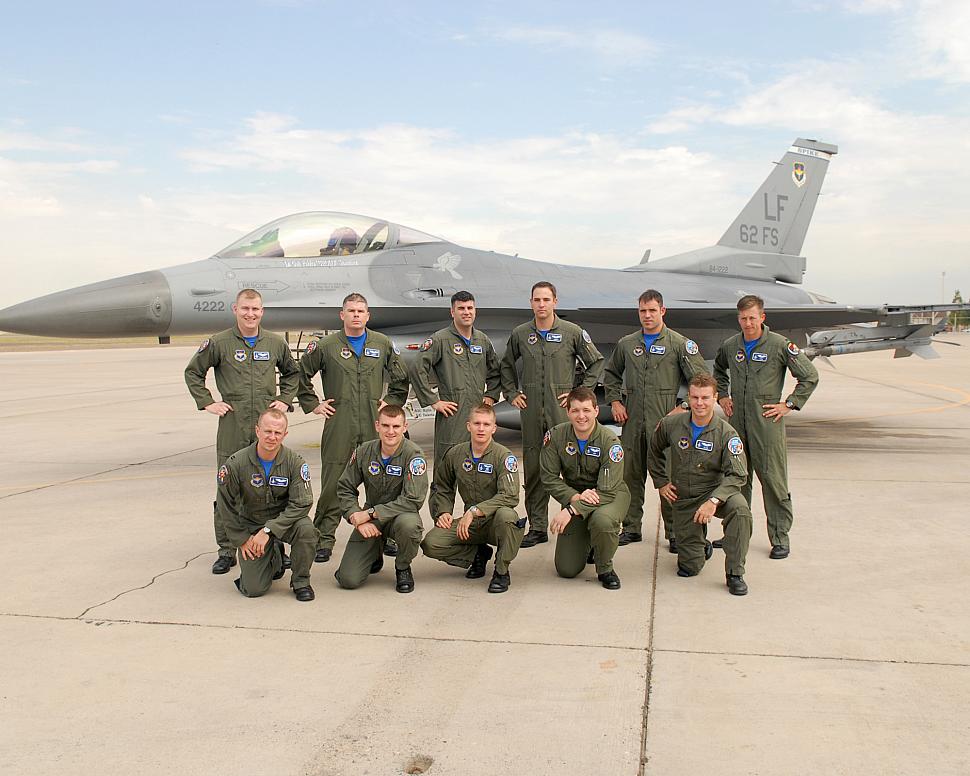Fighter Jet News
F-16 Fighting Falcon News
62d FS graduates 11 new Viper drivers
September 24, 2007 (by
Lt. Col. Pablo Sanchez) -
2007 began, a pack of young pilots gathered for training in the F-16 as part of 62nd Fighter Squadron in class 07-CBC.
Representing a snapshot of the Air Force itself, they hailed from the shores of Maryland to California and all places in between. Nine months later, the 62nd FS is proud to graduate eleven new wingmen and send them on to the combat Air Force.
These wingmen began their journey with a month of arduous academics to prepare them for handling a $20 million fighter aircraft all by themselves. They were put through numerous emergency procedure simulators to train their responses to dangerous situations and were finally ready to fly the F-16. Within a month of strapping into the cockpit, these students were taking the Viper solo and mastering the rudimentary flying skills that would form the basis for the rest of the B-course.
Training moved into the air-to-air phase, where the students quickly learned the importance of handling the Viper like the weapon system it is. The Spikes put the students through the paces, teaching them essential skill sets like offensive and defensive basic fighter maneuvers and tactical intercepts, before culminating the phase with an air combat tactics ride that pitted the students and instructors against an unknown number of adversary or "Red Air" F-16s.
Once done with air-to-air, 07-CBC quickly began to learn the bread-and-butter mission of the F-16 -- surface attack. Following the same stepping-stone approach to learning, the students began with eight sorties to controlled ranges to practice their basic bombing skills. They then moved into the surface attack tactics phase, where they flew low level routes to targets they had never seen before. The air-to-ground phase concluded with two exercises -- operations Rabid Boxer and Trojan Warrior.
Rabid Boxer was a large force-employment exercise where students, opposed by Red Air F-16s, fought their way in and out of the target area while attacking strategically important targets. Trojan Warrior teamed the students with forward air controllers from the 310th FS, giving them realistic training and experience in a close-air-support environment.
The students then transferred to the 310th FS for two months of night attack operations.
Through a rigorous academic, simulator and flight schedule, the students picked up the basic skills of using targeting pods, dropping laser guided bombs and flying with
night vision goggles.
Of course, these students would never have been able to complete this training without the flawless support from the numerous base agencies that made the flying mission possible. From life support to the weather shop, the endless hours put in by the 62nd Air Maintenance Unit maintainers and crew chiefs, to the outstanding academic and simulator support provided by Lockheed instructors, the students' success is no less than a validation of every mission accomplished at Luke. Without Team Thunderbolt, their training would have been over before it began.
These wingmen began their journey with a month of arduous academics to prepare them for handling a $20 million fighter aircraft all by themselves. They were put through numerous emergency procedure simulators to train their responses to dangerous situations and were finally ready to fly the F-16. Within a month of strapping into the cockpit, these students were taking the Viper solo and mastering the rudimentary flying skills that would form the basis for the rest of the B-course.
Training moved into the air-to-air phase, where the students quickly learned the importance of handling the Viper like the weapon system it is. The Spikes put the students through the paces, teaching them essential skill sets like offensive and defensive basic fighter maneuvers and tactical intercepts, before culminating the phase with an air combat tactics ride that pitted the students and instructors against an unknown number of adversary or "Red Air" F-16s.
Once done with air-to-air, 07-CBC quickly began to learn the bread-and-butter mission of the F-16 -- surface attack. Following the same stepping-stone approach to learning, the students began with eight sorties to controlled ranges to practice their basic bombing skills. They then moved into the surface attack tactics phase, where they flew low level routes to targets they had never seen before. The air-to-ground phase concluded with two exercises -- operations Rabid Boxer and Trojan Warrior.
Rabid Boxer was a large force-employment exercise where students, opposed by Red Air F-16s, fought their way in and out of the target area while attacking strategically important targets. Trojan Warrior teamed the students with forward air controllers from the 310th FS, giving them realistic training and experience in a close-air-support environment.
The students then transferred to the 310th FS for two months of night attack operations.
Through a rigorous academic, simulator and flight schedule, the students picked up the basic skills of using targeting pods, dropping laser guided bombs and flying with
night vision goggles.
Of course, these students would never have been able to complete this training without the flawless support from the numerous base agencies that made the flying mission possible. From life support to the weather shop, the endless hours put in by the 62nd Air Maintenance Unit maintainers and crew chiefs, to the outstanding academic and simulator support provided by Lockheed instructors, the students' success is no less than a validation of every mission accomplished at Luke. Without Team Thunderbolt, their training would have been over before it began.
Courtesy of the 62d Fighter Squadron
Related articles:
Forum discussion:
Tags
- Luke F-16s deploy to play 'red air' against F-22s (2007-07-31)
- Arizona Governor signs bill to protect Luke airfield (2004-04-21)
- F-16 Fighting Falcon news archive
Forum discussion:
- Start a discussion about this article in the F-16.net forum.
Tags

